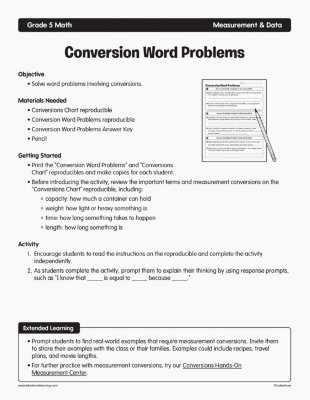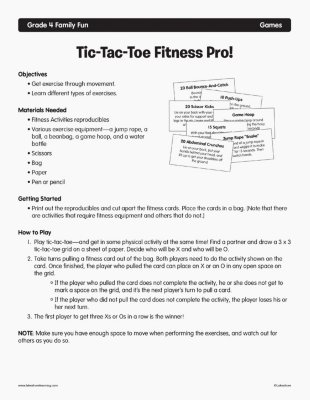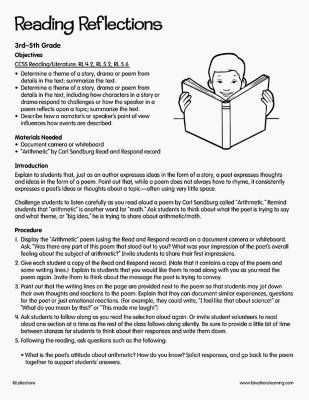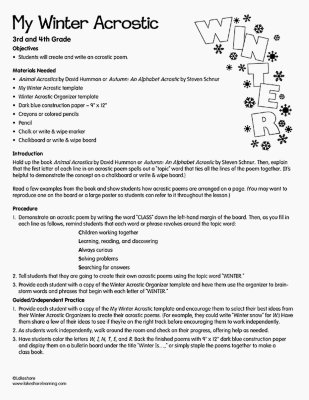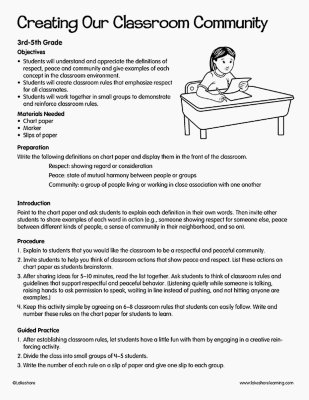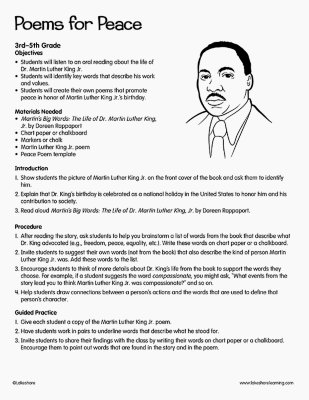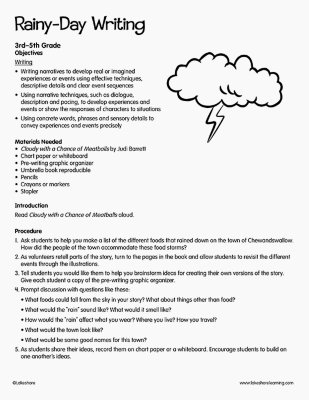Narrow by Grade
- Infant (0)
- Toddler (0)
- Preschool (0)
- Pre-K (0)
- Kindergarten (0)
- 1st (0)
- 2nd (0)
- 3rd (3)
- 4th (3)
- 5th (7)
- 6th & Up (0)
Grade
Narrow by Age
- 0-18m (1)
- 18-36m (3)
- 3 yrs. (0)
- 4 yrs. (14)
- 5 yrs. (20)
- 6 yrs. (19)
- 7 yrs. (18)
- 8 yrs. (16)
- 9 yrs. (17)
- 10 yrs. (7)
- 11 yrs. & Up (0)
Age 10 yrs.
7 results for "word"
Filters
Clear All
Conversion Word Problems
5th Grade
Objective
- Solve word problems involving conversions.
Equation Match-Ups
5th Grade
Objectives
- Work with variables and expressions.
- Understand how to solve simple problems.
- Write equations to solve word problems.
Reading Reflections
5th Grade
Objectives CCSS Reading/Literature: RL.4.2, RL.5.2, RL.5.6 Determine a theme of a story, drama or poem from details in the text; summarize the text. Determine a theme of a story, drama or poem from details in the text, including how characters in a story or drama respond to challenges or how the speaker in a poem reflects upon a topic; summarize the text. Describe how a narrator’s or speaker’s point of view influences how events are described. Materials Needed Document camera or whiteboard “Arithmetic” by Carl Sandburg Read and Respond record Introduction Explain to students that, just as an author expresses ideas in the form of a story, a poet expresses thoughts and ideas in the form of a poem. Point out that, while a poem does not always have to rhyme, it consistently expresses a poet’s ideas or thoughts about a topic—often using very little space. Challenge students to listen carefully as you read aloud a poem by Carl Sandburg called “Arithmetic.” Remind students that “arithmetic” is another word for “math.” Ask students to think about what the poet is trying to say and what theme, or “big idea,” he is trying to share about arithmetic/math.
View Lesson PlanMy Winter Acrostic
3rd Grade - 5th Grade
Objectives Reading: Literature Reading and comprehending grade-appropriate literature, including stories, dramas, and poetry Writing Writing an acrostic poem Materials Needed Animal Acrostics by David Hummon or Autumn: An Alphabet Acrostic by Steven Schnur My Winter Acrostic template Winter Acrostic Organizer template Dark-blue construction paper - 9" x 12" Crayons or colored pencils Pencil Chalk or write & wipe marker Chalkboard or write & wipe board Introduction Hold up the book Animal Acrostics by David Hummon or Autumn: An Alphabet Acrostic by Steven Schnur. Then explain that the first letter of each line in an acrostic poem spells out a “topic” word that ties all the lines of the poem together. (It’s helpful to demonstrate the concept on a chalkboard or write & wipe board.) Read a few examples from the book and show students how acrostic poems are arranged on a page. (You may want to reproduce one on the board or a large poster so students can refer to it throughout the lesson.)
View Lesson PlanCreating Our Classroom Community
3rd Grade - 5th Grade
Objectives Understanding and appreciating the definitions of respect, peace and community, and giving examples of each concept in the classroom environment Creating classroom rules that emphasize respect for all classmates Working together in small groups to demonstrate and reinforce classroom rules Describing people, places, things and events with relevant details, expressing ideas and feelings clearly Materials Needed Chart paper Marker Slips of paper Introduction Point to the chart paper and ask students to explain each definition in their own words. Then invite other students to share examples of each word in action (e.g., someone showing respect for someone else, peace between different kinds of people, a sense of community in their neighborhood).
View Lesson PlanPoems for Peace
5th Grade
Objectives Students will listen to an oral reading about the life of Dr. Martin Luther King Jr. Students will identify key words that describe his work and values. Students will create their own poems that promote peace in honor of Martin Luther King Jr.’s birthday. Materials Needed Martin’s Big Words: The Life of Dr. Martin Luther King, Jr. by Doreen Rappaport Chart paper or chalkboard Markers or chalk Martin Luther King Jr. poem Peace Poem template Introduction Show students the picture of Martin Luther King Jr. on the front cover of the book and ask them to identify him. Explain that Dr. King’s birthday is celebrated as a national holiday in the United States to honor him and his contribution to society. Read aloud Martin’s Big Words: The Life of Dr. Martin Luther King, Jr. by Doreen Rappaport.
View Lesson PlanRainy-Day Writing
3rd Grade - 5th Grade
Objectives Writing Writing narratives to develop real or imagined experiences or events using effective techniques, descriptive details and clear event sequences Using narrative techniques, such as dialogue, description and pacing, to develop experiences and events or show the responses of characters to situations Using concrete words, phrases and sensory details to convey experiences and events precisely Materials Needed Cloudy with a Chance of Meatballs by Judi Barrett Chart paper or whiteboard Pre-writing graphic organizer Umbrella book reproducible Pencils Crayons or markers Stapler Introduction Read Cloudy with a Chance of Meatballs aloud.
View Lesson Plan